















Yellow-bibbed Lory,Lorius chlorocercus , is a large lory up to 33cm in length.
It is an overall red colour with green wings, green tail, black cap and black
neck patches, and a distinctive yellow bib. Eyes are light brown, beak is
large and orange with black near nostrils, thighs white/blue/green/black and
feet black. (Female has more green in thighs with male more blue)
We have eight Yellow-bibbed Lories. (as of 2 August 2001)
The first two, Nippy and Freddie, arrived early 2000, in January and
February. Both are lovable
characters wih distinct personalities and really enjoy human company.
Bothe Nippy and Freddie are over 4 yers old (as of December 2001|)
Freddie has a problem with one leg which looks as though it was
broken and has healed in a strange shape. One of his claws on the odd leg
is twisted backwards but he not concerned about this. He still uses that
claw to hold food.
Nippy seldom flies, instead she will make great efforts to walk, climb and
hop her way around her aviary, although She can fly very well.
Freddie is the opposite, he gets
a real thrill from flying at every opportunity. His odd leg just makes
landing a tad interesting unless it is a well know perch or a convenient
human arm held out as a landing stage.
Although Nippy and Freddie were paired together from early 2000 they never
bonded, Nippy always rejected Freddie and eventually when the opportunity
came to buy an 8year+ old female Yellow-bib (Polly) she was paired with
Freddie in late 2000 and has bonded with him since early 2001.
Another pair of Yellow-bibs was purchased in mid 2000, Danny and Dolly, these were about one year old. Unfortunately Dolly was found to have PBFD and died in April 2001 although she had been removed from our aviaries in December 2000. Danny was eventually paired with Nippy and after six months together they finally bonded in late 2001.
A third pair of Yellow-bibs was purchased in April 2001, these were supposed to be an established breeding pair but by the end of 2001 have not produced any eggs.A fourth pair was purchased in August 2001. These were the parents of Freddie (and possibly Dolly) and from these a baby Yellow-bib was hand raised from an egg they abandoned in September 2001
click on image below to display full size
















|
7 July 2000
Two new Yellow Bibs arrived today, A male and female both apparently aged
about 1 year. Although not a bonded pair they are very friendly
both to each other and to humans. The female we have named Dolly, she looks
a little odd as her plumage colours look a bit different to normal. Instead
of a complete black cap she has several red feathers amongst the black and
her wings have some yellow feathers instead of the complete green covering
normal for a Yellow Bib.
We have been told this is a diet problem so perhaps with time and a good
varied diet her plumage may become more normal.
The male looks quite normal.
Both Yellow Bibs are extremely lively and just love eating and eating and
eating. Everything that has been offered to them has been consumed with great
delight, whistles, clucking, cooing and all sorts of strange noises. Grapes
are an especially liked treat.
9 July 2000
The new Yellow Bibs have now settled in to their new avairy. These are two of
the friendliest and active birds we have and they just love human company.
Neither is the slightest aggressive and now they appear to have bonded.
The first night they slept apart but the last two nights they have been tight
together and have been seen preening and cooing at each other. The female is
the boss but she will share all food with the male and there seems to be no
jealousy between them. They enjoy being hand fed and will carefully preen
and play in human hair and ears.
The female has been seen stripping green bark from a camphor tree, gently
chewing it then spreading the juice into her feathers. She spent an hour
doing this all the while whistling and cooing.
click on image below to display full size





|
6 October 2000
Our fifth Yellow bib arrived two days ago. A female whose age is not exactly
known but from the previous owner we know she is at least eight years old.
She arrived with three olive Scaly lorikeets, all from the same person we
obtained the eight Scalies and Olive Rainbow in June this year. These were the
last birds he had available.
This female Yellow bib is very quiet and inquisitive, appears quite friendly
and not afraid of humans. Her red plumage is a more orange/red colour when
compared to our other four Yellow Bibs.
Within a day of arriving she has noticed the other Yellow Bibs and has been
quiety calling them with low whistles, they are all within a few metres of
each other although not in adjacent aviaries.
click on image below to display full size



|
12 December 2000
Sadly, today we learned that Dolly has beak and feather virus, our local avain
vet had taken blood samples from several of our Lories after it had been
reported to us that a local bird breeder (from whom we obtained several birds,
Yellow bibs Danny and Dolly, a male Bluestreak and a pair of Edwards) has
supplied birds with this virus.
Other bird owners who also had birds tested positive for this virus have
had the birds euthanised by various means but we decided to keep Dolly as she
still is active and her quality of life is excellent. We could not keep her
anywhere near our other birds who all tested negative for the virus so
after talking to my parents who live about 30 kilometers away they agreed to
take Dolly and provide her with a home.
Before moving Dolly we had the vet give her a full inspection as there would
be little point in keeping her if she was ill or suffering in any way.
She did not have any secondary infections, weight was good and apart from
some bendy and fall out feathers she was in overall good condition. With the
vet's recommendation of keeping low sugar content in her food she was taken
to her new home.
Danny, her partner, has tested negative to the virus although he has to be
retested in February 2001 to ensure he has not been infected by his close
contact with Dolly for several months.
click on image below to display full size






|
10 March 2001
The new Yellow bib female, now named Polly, has now settled in very nicely
and is sharing an aviary with Freddie. The good news is that after installing
a new, just right for Yellow-bibs nestbox, both Polly and Freddie are now
spending some time in the nestbox. Maybe we will see some eggs in the not too
distant future.
They have definitely bonded together. Freddie and Nippy never quite accepted
each other, although Freddie would often try to get friendly with Nippy he
would most often be attacked then he in turn would fight back. This resulted
in a very stand-off relationship.
click on image below to display full size

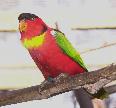

|
20 April 2001
Today we bought a breeding pair of Yellow-bibbed Lories. These are supposed
to be about 4 years old and have laid eggs although none have made it
through to hatching. These birds have come from an aviary where there are
also yellow-backed chattering lories. We will be obtaining these later next
month.
click on image below to display full size




|
30 August 2001
Just a day before the yellow-bib egg was due to hatch and the egg has
disappeared. Only a small fragmnet of the egg was found and this was part of
a near fully developed chick. As yet we are unsure what happened but we have
ruled out rodents being responsible. It is most likey the male got into the
nestbox and destroyed the egg as just yesterday the female was scared out
of the nestbox by two Sun Conures that invaded their aviary.
click on image below to display full size







|
8 October 2001
After sitting on two apparently fertile eggs for two weeks the female
abandoned them. It seems both had disappeared (again!) but a search next day
found one buried in the nestbox. This egg was removed and placed under Rainbow
lorikeets that had infertile eggs.
25 December 2001
Our first Yellow-bib baby is now just over 2 months old. She is from the
breeding pair we obtained in August and is from the third lot of eggs they
produced since August. This pair or the male appear to have difficulty in
keeping fertile eggs until they hatch. Twice now there have been fertile
eggs that have either disappeared or been abandoned.
Two eggs laid in September appeared to be fertile but after two weeks
disappeared. A day or so later one was found buried in the nestbox, retrieved,
and placed under a pair of Rainbow lorikeets who were sitting on infertile eggs.
The yellow-bib egg hatch and the Rainbows fed the baby for 2 weeks before
abandoning it. It was then hand raised. After a few days another abandoned
baby scaley of the same age was kept with the yellow-bib for company. This
kept both babies much quieter. Images below show its development
until about 9 weeks old when it fledged and was placed in a communal aviary
where it quickly established itself as the boss over musks, scaleys and
red-collars.
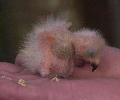
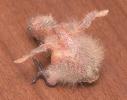

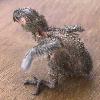

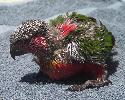

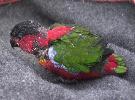
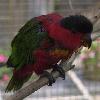
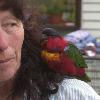

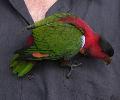
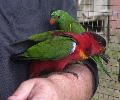
|
